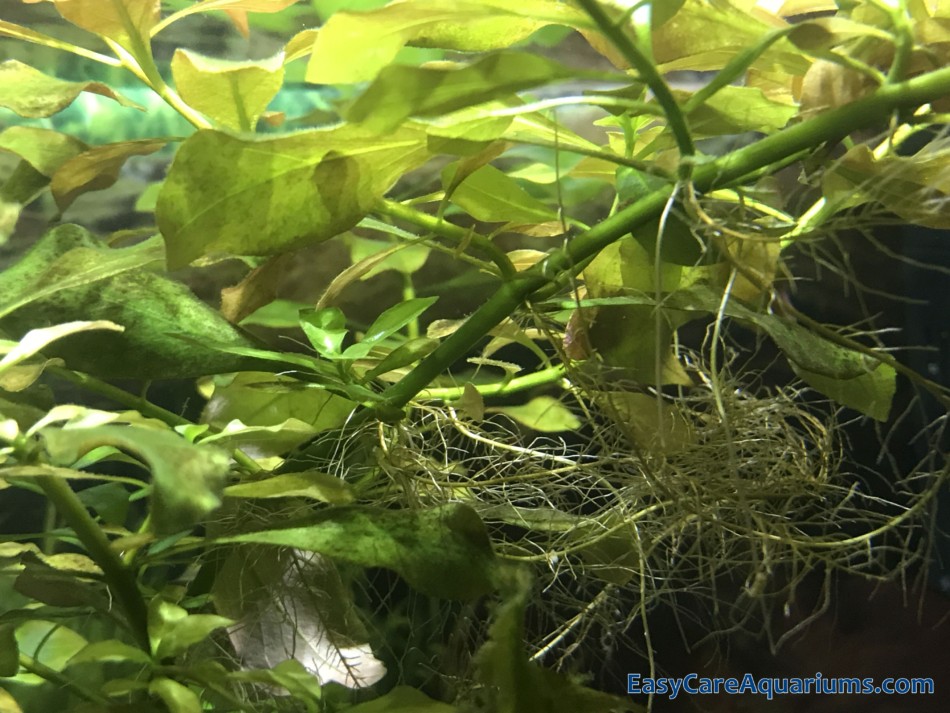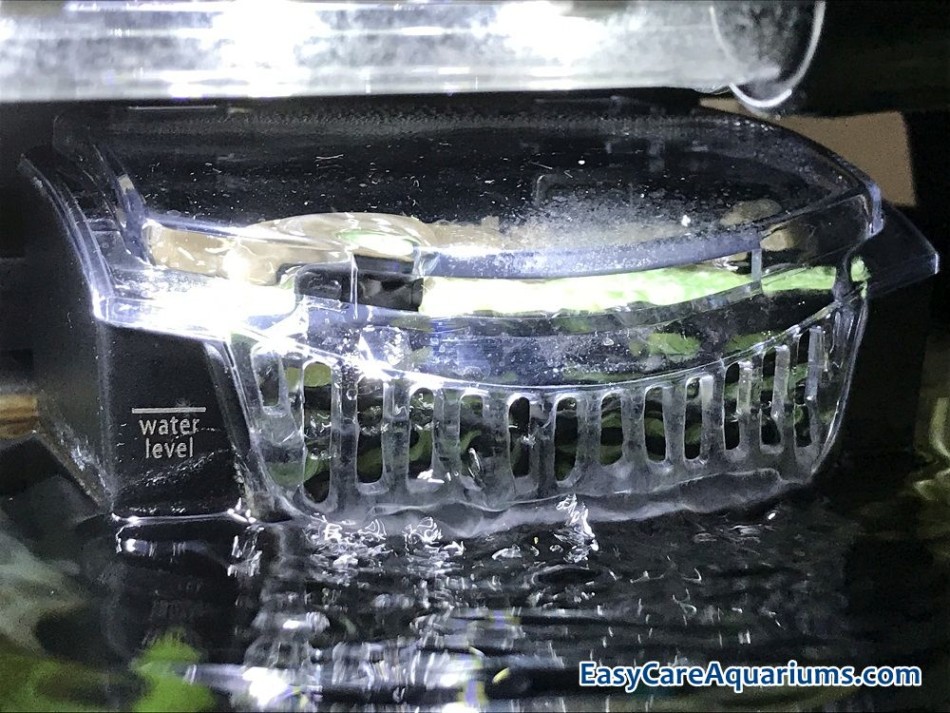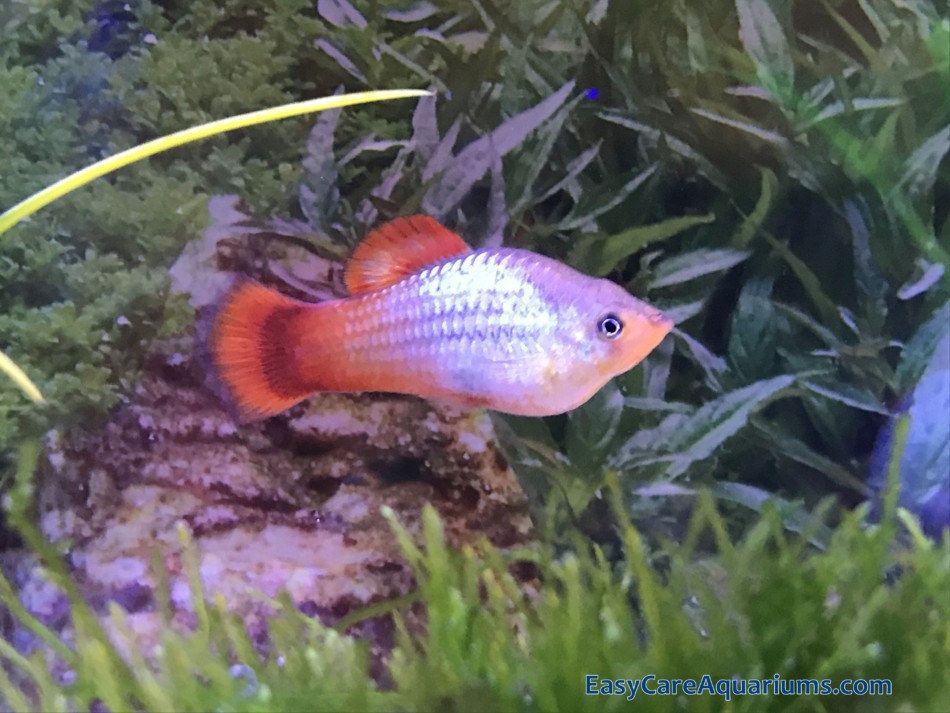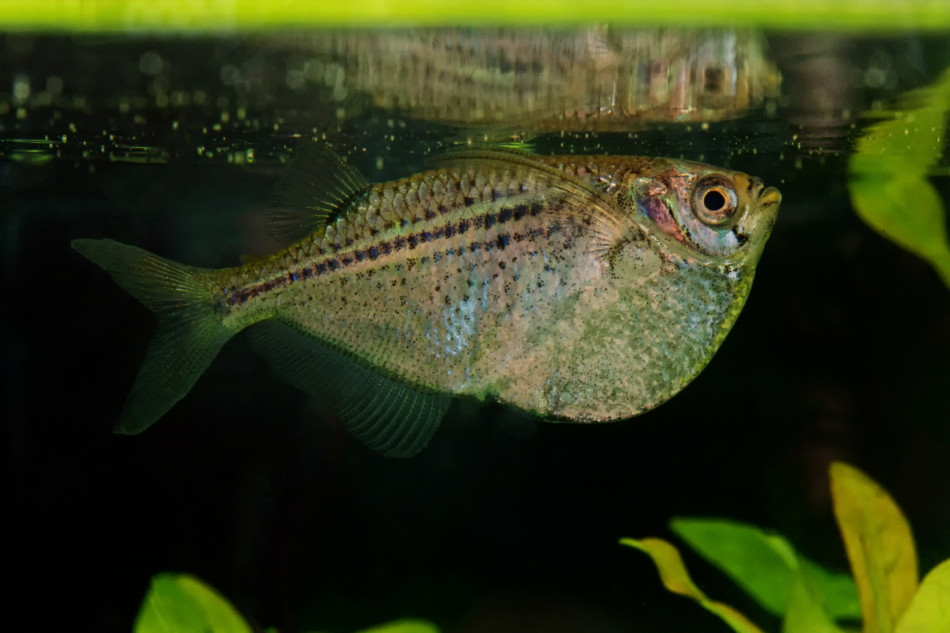This article may contain some affiliate links to products. The links provide me a small percentage of commission but do not cost you anything extra to use. (See full disclosure statement here ).
).
Although Hatchetfish swim, feed and breed, close to the water’s surface it doesn’t mean that the rest of the tank should be left bare. The general tank environment is important for them too.
The best tank setup for Hatchetfish is one that includes plenty of plants, a moderate to fast flow and a low to medium light level. Because they are a tropical fish the tank water needs to be heated. The water also needs to be clean and oxygenated. The addition of wood, rocks, leaf litter and a darker substrate, all help to create a more natural environment.
Whether you’re setting up a Hatchetfish only tank, or starting off/adding them to an existing community tank, you can keep things easy-care. It doesn’t need to be complicated when it comes to keeping these interesting ‘oddball’ fish happy and healthy.
Tip: Decide how many Hatchetfish you want to keep before buying a tank. If you buy the tank first the size of the tank will dictate how many of them you can keep. If you’re adding Hatchetfish to an existing community tank you need to take both the tank size, and the number of established inhabitants, into account before buying more fish.
Choosing A Tank For Your Hatchetfish
Hatchetfish are a shoaling fish which means that they prefer to live in groups. So It’s best to keep at least 6 together as a bare minimum number. When it comes to how many to keep together it’s a case of ‘the more the merrier’. And a large shoal of these fish hanging out together at the top of the tank makes an impressive display.
Once you’ve decided how many Hatchetfish you want to keep you can start looking for the right tank.
Because Hatchetfish are a small fish you don’t have to have a huge tank. Although you will need a decent sized tank if you want to keep a larger shoal of them.
It’s always best to buy the biggest tank that your budget and available space will allow.
What Size Tank Will Your Hatchetfish Need?
A general guide to tank size for 6-8 Hatchetfish is 20 US Gallons/16.65 UK Gallons. So in litres we’re talking between Approx. 75-76 Litres. And because Hatchetfish are surface dwellers it’s better if the tank is long rather than tall.
The actual tank size you will need for your Hatchetfish will depend on a few things. It’s a good idea to take the points below into account before buying an aquarium.
- The number of Hatchetfish you want to keep
- The size of Hatchetfish when they’re adult (average 1-3 inches/2.54-7.62 cm) depending on type
- Plenty of room for plants but leaving plenty of swim-room at the surface
- Room for any other fish/shrimp/snails that will share the tank
- Spare litres/gallons in case your Hatchetfish or their tankmates breed
If you would like more information about how Hatchetfish reproduce read my article ‘How Do Hatchetfish Breed? ‘
‘
As you can see from the list above there are a few basic things to consider when you’re choosing the right tank for your Hatchetfish. And it’s impossible for me to tell you what size tank to buy because I don’t know exactly what you have in mind.
My advice though is to make a plan taking all of the points above into account. Then speak to your local Pet Store or Aquatic Dealer for advice on a suitable tank that will comfortably accommodate all of your planned inhabitants and will also allow room for possible fry (babies).
There’s no ‘one-size-fits-all’ when it comes to choosing the right tank for your fish. So having a plan and getting some guidance is a great help. Particularly if you’re new to the fish keeping hobby.
Note: It’s always better to understock rather than overstock a tank, particularly in a new tank setup. If you add too many fish at once you run the risk of an ammonia spike which can be fatal to your fish.
Tip: Hatchetfish are also known as flying fish because of their ability to leap out of the water to escape predators. They can jump a great height compared to their size and can travel through the air for quite some distance. So if you’re keeping Hatchetfish in your aquarium you will need a close fitting lid that doesn’t have any gaps that they can jump through.
What’s The Best Tank Layout For Hatchetfish?
Hatchetfish are an easy-care fish. Although some fishkeeping experience is helpful. They’re not too fussy about their tank layout but that doesn’t mean that you shouldn’t do your best to give them at least the basic things that make them feel at home. The closer you make the tank environment to their native habitat the happier they will be.
Hatchet fish are native to South and Central America where the water is on the softer side and slightly acidic. The water is also often tannin stained from the natural addition of fallen branches, leaf debris, seed pods and other decaying plant life. The bed of the waterway will also contain rocks and pebbles and other naturally occurring debris.
I know that keeping fish in any tank setup isn’t going to be the same as their native environment. No matter how much you try to replicate it. However, most of the fish we buy from Pet Stores/Aquatic Dealers have been captive bred for many generations and are generally adapted to aquarium life already. But that doesn’t mean that we shouldn’t do our best to make their lives as comfortable as possible. And if the fish are happier they’re less likely to suffer from stress and stress related illnesses.
A Good Tank Layout For Hatchetfish Generally Includes:
- Plants – A planted tank is great for Hatchetfish. Floating plants in particular are beneficial. But you can use stem and epiphyte plants in the lower areas of the tank. A combination of all of these plant types is even better (there’s more information about plants/types both live and fake in the next section).
- Rocks/Pebbles
 – (Amazon link) You can use these to create a more natural look to the bottom of your aquarium.
– (Amazon link) You can use these to create a more natural look to the bottom of your aquarium. - Wood
 – (Amazon link) Wood and twigs are another useful and attractive addition to a Hatchetfish tank. And they contain beneficial tannins which is a bonus.
– (Amazon link) Wood and twigs are another useful and attractive addition to a Hatchetfish tank. And they contain beneficial tannins which is a bonus. - Leaf Debris – Helps to create a more natural look and feel to the tank. Catappa Leaves
 (Amazon link) are a good choice because they release beneficial tannins into the water. But you can use other leaves too, such as Oak Leaves for example.
(Amazon link) are a good choice because they release beneficial tannins into the water. But you can use other leaves too, such as Oak Leaves for example. - Substrate – Darker, natural looking substrates work well in a Hatchetfish tank. Pebbles/Stones/Gravel
 (Amazon link) are good options. But any kind of substrate that you prefer will be okay for your Hatchetfish because they don’t interact with the substrate.
(Amazon link) are good options. But any kind of substrate that you prefer will be okay for your Hatchetfish because they don’t interact with the substrate.
You can also use other things such as Seed Pods and Alder Cones to create a ‘bottom of the riverbed’ look.
Tip: Make sure that any Wood/Twigs, leaves and/or Alder Cones etc are aquarium safe. This is particularly important if you forage for them yourself. Any natural tank debris needs to be pest and pesticide free or you risk poisoning your fish.
Even if you’re trying to create a more natural feel to your Hatchetfish tank it doesn’t mean that you can’t include other tank decorations too. You can add other things that you would like to see in your tank. Or add other stuff your Hatchetfish tankmates would like or need.

Do Hatchetfish Need A Planted Tank?
Hatchetfish do well in a planted tank. Not only do plants create a more natural environment they serve other purposes too, such as helping to clean and oxygenate the water. Floating Plants and their roots make great places for your Hatchetfish to breed/spawn in. They also provide safer areas for Hatchetfish fry (babies) to hide in while they grow. Plus, live plants provide shelter and resting places for your adult fish.
If you’re not sure which plants to use, or you haven’t used live plants before, I’ve got some suggestions for you.
Take a look at the plant info below.
Easy-Care Floating Plants For A Hatchetfish Tank
When it comes to keeping Hatchetfish floating plants are important. So I’ve given you a short list below of some easy-care floating plants that your Hatchetfish will appreciate.
- Giant Duckweed – fast growing (can be invasive if you don’t keep it under control)
- Salvinia
- Amazon Frogbit
- Bacopa – some types make good floating plants with long root systems
- Hornwort
- Water Sprite
- Red Root Floaters – small leaved floating fern plants that develop a red colouring over time (one of my favourites)
There’s lots of other floating plants to choose from. Water Spangles, Floating Mosses and Anacharis are just 3 examples.
Tip: Although Hatchetfish need floating plants it’s important not to let the plants cover the whole water surface. A quarter to a third of cover is usually enough. So remember to thin out your floating plants regularly so that they don’t take over.
Easy-Care Plants For The Lower Areas Of A Hatchetfish Tank
Although Hatchetfish live their lives near to the top of the water it doesn’t mean that you should leave the lower areas of the aquarium empty. Hatchetfish are a good community fish. This means that you’re likely to want other fish, shrimp and/or snails to live in the mid to lower areas of the aquarium. And your Hatchetfish tankmates are likely to benefit from a planted aquarium too.
Here’s Some Easy-Care Plant Ideas For Your Hatchetfish Tank
- Bacopa Plants (various) – Usually planted but some can be left to float
- Amazon Sword – Long narrow leaved plant (needs planting in the substrate)
- Java fern – Wide leaved plant (can be planted or attached to wood/rocks etc)
- Water Wisteria – Narrow leaved/feathery plant (usually planted in the substrate)
- Vallisneria Plants – Coarse grass-like plants usually planted in the substrate and will spread
- Guppy Grass – Ground covering grass-like plant that spreads when planted in the substrate
- Java Moss, Christmas Moss, Weeping Moss– Feathery mosses (attach to wood/rocks, tank decorations, some mosses can also be floated)
You’ll find many more easy-care stem, rhizome and epiphyte plants at your local pet store/aquatic dealer and online. But I hope the list above gives you a good starting point.
Artificial/Fake Plants For Hatchetfish
I know that not every fish keeper wants to keep live plants. The good news is that you don’t have to keep live plants in your Hatchetfish tank. You can use artificial/fake ones if you prefer. But it’s important to choose ones that have soft leaves and no sharp edges to reduce the risk of injuring your fish. And you need to bear in mind that you won’t get the natural ‘filtering’ benefits that live plants provide. Nonetheless, your Hatchetfish won’t mind that the plants aren’t real.
Remember that it’s important for your Hatchetfish to have floating plants. You can buy artificial/fake floating plants and you can also use a Spawning Mop.
If you would like more information about what a Spawning Mop is, and what it’s used for, read my article ‘What Is A Spawning Mop?’
If, over time, you decide to try some live plants in your tank the lists and suggestions in the plant sections above will be helpful.
Tip: When choosing a filter for your tank make sure it can cope with both the tank’s water capacity and the number of fish you are keeping. Some types of fish are messier than others, so remember to take that into account too.

Do Hatchetfish Need A Filter?
Hatchetfish need a filter in their tank because their water needs to be clean, filtered and oxygenated. They don’t like dirty/poor water conditions. Tank filters not only help to clean the water they oxygenate the water too by moving the water around and breaking the water’s surface. The water movement creates flow in the tank. Hatchetfish, in an aquarium, prefer a moderate flow to fast flow with calmer areas created by floating plants.
Filters also serve another important purpose. They’re great breeding grounds for the beneficial bacteria that help to keep your tank environment a healthy one.
Any type of filter you prefer will be fine for your Hatchetfish. That’s as long as it provides efficient filtration and enough flow for your Hatchetfish and any tankmates they share the tank with.
Tip: Even if you have an efficient filter in your Hatchetfish tank you still need to keep on top of your tank maintenance. Aquarium filters are a great help in keeping the water healthy but they should be used alongside your regular tank cleaning.
Do Hatchetfish Need A Tank Light?
Hatchetfish need regular periods of light and dark. One way, and the easiest way, to achieve this is to install a tank light. However, the light doesn’t need to be super bright. A low to medium lighting level is enough or you will find that your Hatchetfish spend a lot of time hiding under the cover of the floating plants. And the light needs to be turned off at night to allow them to rest.
Do Hatchetfish Need A Tank Heater?
A heater is recommended if you’re going to keep Hatchetfish. The ideal temperature range for Hatchetfish is between approximately 22-27 Degrees Celsius (Approx. 72-81 Degrees Fahrenheit). But they can tolerate the water a little cooler and a little warmer. You will need a tank heater unless you live in a climate that will keep the water within this temperature range 24/7 all year round. And even then it’s best to keep the temperature stable rather than having it rise and drop too much.
The wide temperature range is helpful if your Hatchetfish will be living in a community tank. It makes it easier to set the temperature to suit all of your tank inhabitants.
Tip: An easy way to check your tank temperature is to add a aquarium thermometer. They are cheap to buy and are a simple but useful tool for monitoring the temperature of your tank water. They’re also a good way to check that your aquarium heater is working properly.
What Kind Of Water Is Best For Hatchetfish?
Hatchetfish prefer softer slightly acidic water but they also do well in other water parameters too. The naturally occurring seasonal changes to the water parameters in their native habitat make them adaptable. And the Hatchetfish you buy from your pet store or aquatic dealer are likely to have been aquarium bred in non-native water rather than wild caught. But check with your supplier just in case.
In their native environment the water Hatchetfish live in is often tannin stained from the wood and plant debris that falls into the water. But that doesn’t mean that you have to keep them in a black water tank.
In the aquarium hobby a black water tank is a tank that contains lots of leaves, twigs and wood etc that release tannins and turn the water brown. As you will probably notice in your pet store or aquatic dealers Hatchetfish do well in clear fresh water aquariums too.
You can create a black water tank for your Hatchetfish if you want to. You’ll also find other fish, shrimp and snails that will appreciate that type of environment too.
The main point about the water quality in a Hatchetfish tank is that it’s kept clean, filtered and oxygenated. The easiest way to keep the water clean is to carry out regular tank maintenance alongside what your aquarium filter is doing on a 24 hour basis.
Don’t overfeed your Hatchetfish. Excess food fouls up the water causing dangerous levels of ammonia, nitrite and nitrate that can kill your fish. So don’t be tempted to give them just a little bit more food.
If you would like more information and tips about what/how much to feed your Hatchetfish, both the adults and the fry (babies), click the link to read my article ‘What Do Hatchetfish Eat? ‘
‘
Tip: When you set up your Hatchetfish tank, and on all water changes, the water should be dechlorinated using a reputable water treatment product. These products not only eliminate Chlorine and Chloramines they also get rid of any heavy metals that might harm your fish.
Two Tap Water Treatments that are popular with fish keepers are Prime by Seachem and API Tap Water Conditioner (Amazon links) but there are other tap water treatments/conditioners available too.
and API Tap Water Conditioner (Amazon links) but there are other tap water treatments/conditioners available too.
Tankmates For Hatchetfish
The best tankmates for Hatchetfish are peaceful, non-aggressive fish of a similar size. It doesn’t matter if the other fish are a bit smaller but fish that are considerably larger are not a good choice. Large fish, even if they are not generally aggressive, may see your Hatchetfish as a tasty snack.
Hatchetfish are top dwellers so go for fish that prefer the mid to lower areas of the tank. Avoid any fish that live near the water’s surface because your Hatchetfish do better if they have the top area to themselves. You can also add some bottom dwellers and some shrimp and snails because they won’t invade your Hatchetfish’s space.
It’s also best to avoid fast swimming/erratic fish because they can spook your slower moving Hatchetfish which will cause them stress.
Here’s Some Of The Fish/Shrimp/Snails That Make Good Tankmates For Hatchetfish
The list includes links to some of my other articles that will be useful.
- Tetras – e.g. Neon, and Cardinal plus other small peaceful Tetras
- Dwarf Cichlids – e.g. German Blue Ram (keep an eye on the interaction though)
- Chilli Rasboras
 – plus other peaceful small Rasboras
– plus other peaceful small Rasboras
- Platy Fish
 – various
– various
- Molly Fish – various
- Guppy Fish
 – various
– various
- Cherry Barbs
- Otocinclus – dwarf varieties
- Shrimp – e.g. Amano
 , Cherry
, Cherry and Crystal (Hatchetfish will eat any tiny baby shrimplets that stray into the surface area but will leave the larger shrimp alone)
and Crystal (Hatchetfish will eat any tiny baby shrimplets that stray into the surface area but will leave the larger shrimp alone)
- Snails – e.g. Nerite
 and horned Nerite, Rabbit Snails
and horned Nerite, Rabbit Snails , Mystery and Ramshorn
, Mystery and Ramshorn
There are lots of other fish, shrimp and snails that will live happily with your Hatchetfish. But the list above is worth considering if you’re unsure what to include in your Hatchetfish tank.
Also, since I posted this article I’ve probably added more articles on the website about some of the other fish on the list. Plus others too. So it’s worth checking out the category lists on the home page.

Can I Add Hatchetfish To An Established Community Aquarium?
Hatchetfish are a great addition to a peaceful community tank. Particularly if you want to introduce fish that live in the top area of the tank. So, as long as all the established fish, shrimp and snails are likely to get along with the Hatchetfish they’re definitely an interesting option.
Hatchetfish do well in an established/mature tank so adding them to your friendly community tank shouldn’t be a problem.
The Takeaway
I realise that in this article I’ve given you a lot of information about the Best Tank Setup For Hatchetfish. So I thought it was a good idea to create a simple list of the main points that I’ve covered.
Here’s The Takeaway
- Buy a tank that has plenty of swim-room for the number of Hatchetfish you want to keep. You’ll need at least 6 as a bare minimum number. Long tanks are better for Hatchetfish than narrow tall ones. Leave room for fry (babies) and any other tankmates too.
- Use plenty of plants either live or fake. Make sure that you provide your Hatchetfish with floating plants of some kind or a spawning mop.
- Include pebbles/rocks, leaf debris and/or wood, and a substrate of your choice, to create a more natural feel to the tank.
- Filter the tank with a moderate to fast flow but create calmer areas with floating plants.
- Tank lighting needs to be at a low to medium level. Don’t have a super bright light and turn it off at night to create day/night lighting periods.
- The ideal temperature range for Hatchetfish is between approximately 22-27 Degrees Celsius (Approx. 72-81 Degrees Fahrenheit). But they can tolerate the water a little cooler and a little warmer. So you will need a tank heater to keep the temperature stable.
- Water quality should be clean, oxygenated, and free from a build up of toxins. You can also create a black water tank that contains a fair amount of natural tannins if you want to.
- Tankmates need to be of a similar size, non-aggressive, and happy to share the same tank conditions. But they shouldn’t be fish that are also top dwellers.


